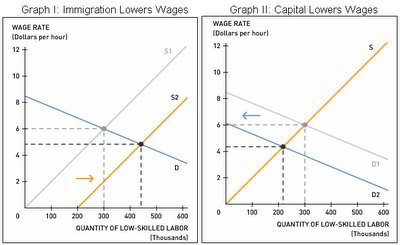Mexico Fights Back
by William Chiu
The U.S. House of Representatives passed a bill last month that included provisions to build a 700-mile wall along the U.S.-Mexico border. The following news articles describe both the political and economic dimensions in this debate.
Mexico Fights Back as U.S. Proposes More Wall to Bar Immigrants
House Approves Immigration Bill
The falling wages of low-skilled workers in the United States is often attributed to an increase in the number of low-skilled immigrants to the United States. However, there are alternative explanations for the fall in low-skilled wages that have nothing to do with immigration.
 A simple supply-and-demand model can provide us with valuable insight on the labor market and its relationship to immigration and capital. Consider the labor market for low-skilled workers. An increase in low-skilled immigrants would increase the supply of low-skilled labor and lower the wage of low-skilled workers in the United States. (Graph I)
A simple supply-and-demand model can provide us with valuable insight on the labor market and its relationship to immigration and capital. Consider the labor market for low-skilled workers. An increase in low-skilled immigrants would increase the supply of low-skilled labor and lower the wage of low-skilled workers in the United States. (Graph I)
However, suppose immigration has no effect on low-skilled wages. Is it still possible to observe a decline in low-skilled wages? Yes. The demand side of the labor market has as much, if not more, impact on wages than the supply side. Capital and technology can be substitutes for low-skilled labor. As the U.S. economy accumulates more labor-saving capital and technologies, the marginal product of low-skilled labor decreases. This causes the demand for low-skilled labor to fall and wages for low-skilled labor to fall as well. (Graph II)
At the same time, capital accumulation and technological innovation raise the marginal product of labor for high-skilled labor to operate and maintain the new machines and ideas. Hence, we expect wages for high-skilled workers to rise in the United States.
Discussion Questions
1. What effect would building a wall along the U.S.-Mexico border have on wages in the United States?
2. If low-skilled workers are displaced by capital (rather than immigration), then what policies should the government pursue?
3. Economists often use cost-benefit analysis to determine whether a policy is worth implementing. What are the costs of immigration imposed on taxpayers, households, and firms? What are the benefits?
4. Economists generally agree that the free trade of goods and services benefits both trading countries. If the free trade of output makes the world better off, does the free trade of inputs (labor) also make the world better off?
For more information on the economic analysis of immigration, you might want to check out the work of George Borjas, from Harvard University, and David Card, from University of California at Berkeley.
Mexico Fights Back as U.S. Proposes More Wall to Bar Immigrants
House Approves Immigration Bill
The falling wages of low-skilled workers in the United States is often attributed to an increase in the number of low-skilled immigrants to the United States. However, there are alternative explanations for the fall in low-skilled wages that have nothing to do with immigration.
 A simple supply-and-demand model can provide us with valuable insight on the labor market and its relationship to immigration and capital. Consider the labor market for low-skilled workers. An increase in low-skilled immigrants would increase the supply of low-skilled labor and lower the wage of low-skilled workers in the United States. (Graph I)
A simple supply-and-demand model can provide us with valuable insight on the labor market and its relationship to immigration and capital. Consider the labor market for low-skilled workers. An increase in low-skilled immigrants would increase the supply of low-skilled labor and lower the wage of low-skilled workers in the United States. (Graph I)However, suppose immigration has no effect on low-skilled wages. Is it still possible to observe a decline in low-skilled wages? Yes. The demand side of the labor market has as much, if not more, impact on wages than the supply side. Capital and technology can be substitutes for low-skilled labor. As the U.S. economy accumulates more labor-saving capital and technologies, the marginal product of low-skilled labor decreases. This causes the demand for low-skilled labor to fall and wages for low-skilled labor to fall as well. (Graph II)
At the same time, capital accumulation and technological innovation raise the marginal product of labor for high-skilled labor to operate and maintain the new machines and ideas. Hence, we expect wages for high-skilled workers to rise in the United States.
Discussion Questions
1. What effect would building a wall along the U.S.-Mexico border have on wages in the United States?
2. If low-skilled workers are displaced by capital (rather than immigration), then what policies should the government pursue?
3. Economists often use cost-benefit analysis to determine whether a policy is worth implementing. What are the costs of immigration imposed on taxpayers, households, and firms? What are the benefits?
4. Economists generally agree that the free trade of goods and services benefits both trading countries. If the free trade of output makes the world better off, does the free trade of inputs (labor) also make the world better off?
For more information on the economic analysis of immigration, you might want to check out the work of George Borjas, from Harvard University, and David Card, from University of California at Berkeley.
Labels: Immigration, Labor, Real Wages



0 Comments:
Post a Comment
<< Home